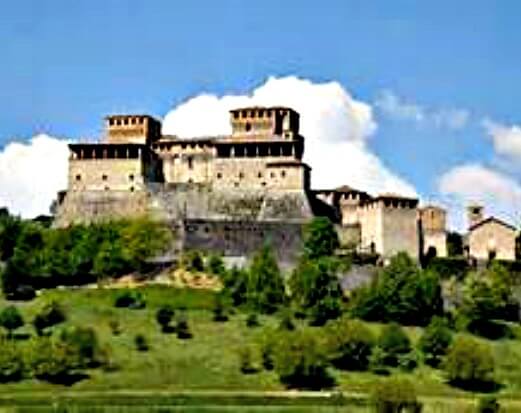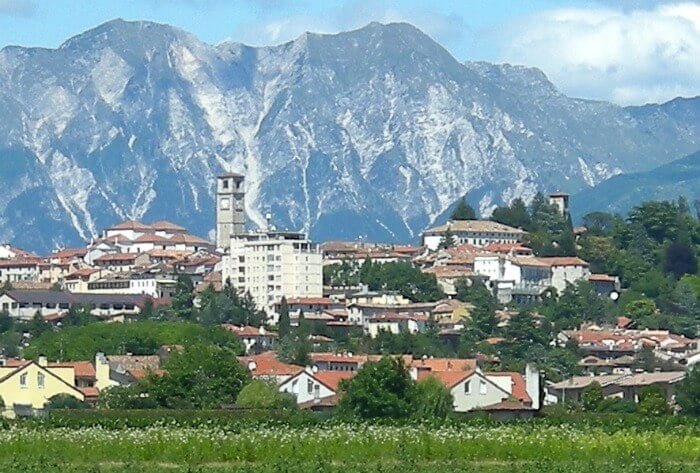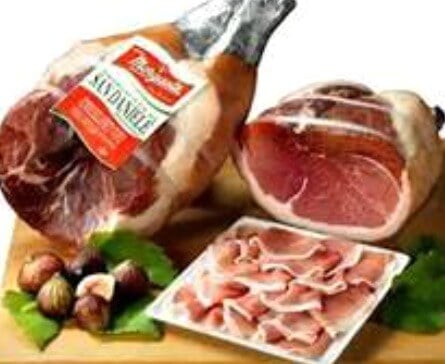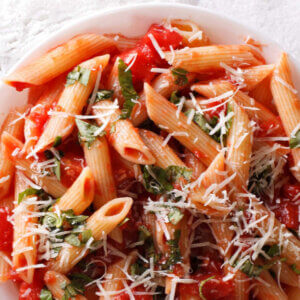We're going on an adventure . . . would you like to join us? You would? Great! You're wondering where we're going? Well, we are going to visit two cities. . . . no . . . not Paris or London. . . our two cities are well known . . . especially to the prosciutto appassionato. Andiamo {lets's go } . . . the car is waiting. . .

I'll explain everything as we go along on our trip. . .because . . .we're going to find out who makes the very best prociutto . . . and why. I'm sure you'll recognize the area we're going to first . . . it is Langhirano, a town in the province of Parma in the Emilia-Romagna region. . . I can see that you do recognize the name Parma. The town sits on a high hill and as such it receives breezes from both the Tyrrhenian and the Adriatic seas . . .Why is that important? Because it's one of the elements that makes a superb prosciutto . . . the other elements are sea salt, time--which is a constant-- and most importantly an Italian pig. . .
. . .you can't hide that smile . . .say it . . .I knew you were going to ask how can you tell if the pig is Italian? You can tell because it's a special breed-- they recognize it --and believe me they keep copious notes on their birth, growth, feed, etc. Look at all those rolling hills. . . can't you just feel that cool, dry, sweet-smelling breeze that's coming from the Apennine Mountains? No wonder they make a wonderful prosciutto . . .they have the perfect environment for curing the Parma hams and giving them their distinctive taste.

What is the Italian name for pigs? The pigs are called maiale -- don't say porco -- it's a word used in crude terms and there are quite a few. The maiale are fed a strict diet and they become quite portly on grains and protein-rich whey -- the water liquid that separates from the curds in the cheese making process of Parmigiano-Reggiano. By the time they are 10 months old they weigh around 330 pounds -- their uncured thighs weigh between 22 to 31 pounds. The thighs are trimmed of the skin and fat, then salted, air cured, greased with salted lard and then air cured again. How long does all of this take? It takes between 9 to 10 months. The human intervention in this process is very important . . . it's a combination of eye, nose, touch, and taste, plus education, sensitivity and the gift of tradition that gives the finished product such a wonderful taste. This process is closely monitored and there can be no preservatives added to the meat. All this is recorded and in the end the thigh is given a tattoo or bollatura -- the Parma prosciutto is tattooed with the PARMA letter circled in the center of the five-point start.

You're asking me why we should go anywhere else when obviously this is a superior prosciutto . . .well it is a superior prosciutto but there is another small town where many say their prosciutto is even better. Where you ask? It is San Daniele . . .a town in the province of Udine in the Fruili-Venezia Giulia region. You think I may be a little prejudiced because I came from that region? Well, lets go visit and find out if their prosciutto does compare to the excellence of the Parma ham.
Here we are . . . it appears that San Daniele also has a hillside climate that's good for curing meat and enhancing its flavor. They say the soil here is excellent for producing the grains that the maiale feed on . . .plus the warm and cold breezes coming from the Alps and from the Adriatic Sea are the ideal curing environment for the meat.

This prosciutto will have a different taste than that of the Parma one. . . the difference in feed and the air are major factors. The maiale for this prosciutto will be nine months old -- younger that that of Parma, and it will weigh more -- around 353 pounds. The thighs will be around 25 pounds and the curing process will take anywhere from 12 months to 2 years. The basic treatment of the prosciutto is the same except more sea salt is used in the San Daniele prosciutto. . . and the shape of the San Daniele prosciutto is like a guitar or violin. . . the Parma prosciutto looks like a chicken thigh.

I can honestly say that both prosciuttos are delicious -- the San Daniele is sweet whereas the Parma prosciutto is savory. The San Daniele Prosciutto is best shaved thin and served with bread or grissini, as an antipasto served with fruit, a small amount of fresh cheese. The perfect wine is pinot grigio or some other light wine. Don't waste the taste of the prosciutto on cooking -- the flavor will be overwhelmed. The prosciutto from Parma can support sautéing while retaining its distinct flavor. This prosciutto has a wider range of uses whereas the prosciutto of San Daniele is for the true lover of prosciutto. The Parma prosciutto should also be sliced paper thin and its perfect use is as an appetizer with bread or an entrée with cheese.
Well . . . we've certainly been given a lot of information to digest . . .I see your grin . . . I assume you like my play on words? I do have a surprise . . .while you were busy looking around the towns . . .I picked up some of their prosciutto, crusty bread, grissini, an assortment of local cheese . . .and several bottles of white wine. By that big smile on your face I take it you approve. Hai fame? Andiamo mangiare! [Are you hungry? Lets go eat!} We'll do it All Our Way!








Comments
No Comments